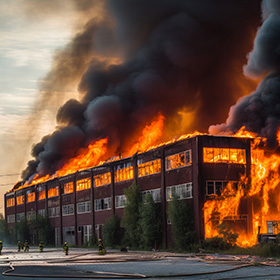Claim Stories: Occupancy Error with Warehouse Fire



We're going to go through a claim scenario that occurred, which will be a lesson learned. And so we'll learn what went right, what went wrong, and could there have been anything been done to help deliver the proper product?
Tell us about this project.
This was a warehouse that was going to be tenant occupied. It was non-combustible construction.
What did the agent get right?
They filled out the application correctly. They asked the insured all the questions, and they got a signed application.
What went wrong?
So, the fire was a total fire loss. The tenant, that had already signed a lease, our insured elected to allow them to go ahead and move their food product in early. The insured had not received a certificate of occupancy.
The city was behind on getting it out, but they thought everything was fine. They passed all their inspections. They would go ahead and allow it.
But, what the insured failed to do is notify the agent that they were going to go ahead and move that tenant in before the construction ended. That caused an issue when their claims adjuster then started review on the claim.
What was the outcome?
The claims adjuster discovered how long that tenant had been in there and it exceeded our policy condition on "When Insurance Begins and Ends" for occupancy. And they had to deny the claim.
Why do pre-leases matter?
Pre-leases are always found to be in any kind of tenant-occupied building. So if you're going to have a leased building when it's completed, you need to ask the question about pre-leases because you need to verify if there's any chance that that tenant can move in sooner.
What should agents do to avoid this situation?
As you go through the policy conditions and the exclusions, you know, highlight the areas that are key and make sure that they sign and or the initial the coverage form sections that you went through. Always tell your insurance, “if anything changes during this construction, please contact me immediately.”
Any final thoughts?
The application that we ask you to sign. Thank goodness the agent had it. In this lesson learned, that's what protected them. That application is not just for the carrier. As you see in this lesson learned, it shows it was also for the agent that protects you and your ano make it like a little check, you know, check mark for all of your staff to make sure you follow through and end with this on any kind of quote and policy issuance you do. But, always do it at the time of quote, where they understand it before you bind and insure the policy, not after.
This is intended as a general description of certain types of insurance and services available to qualified customers. Any description of policy provisions is meant to give a broad overview of coverages and does not revise or amend a policy. Refer to the policy coverage form for a complete representation of the scope of coverage, terms, conditions, exclusions and more. The policy is the contract that specifically and fully describes your coverage. Some products may not be available in all states and may only be offered on a non-admitted basis. Product availability is subject to change.










